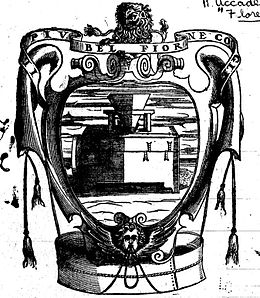- Accademia della Crusca
-
 Emblem of the Accademia della Crusca, depicting a sieve straining out corrupt words and structures (as wheat is separated from chaff).
Emblem of the Accademia della Crusca, depicting a sieve straining out corrupt words and structures (as wheat is separated from chaff).
The Accademia della Crusca (Academy of Chaff) is an Italian society for scholars and Italian linguists and philologists established in Florence. After the Accademia Cosentina, it is the oldest Italian academy still in existence. The academy was asked to join the 'European Federation of National Linguistic Institutes', a body convened to develop a joint policy to protect the purity of national languages. The Federation has two Italian members: the Accademia della Crusca and the Opera del Vocabolario Italiano del CNR (an initiative launched by the CNR with the collaboration of the Accademia della Crusca).
The Accademia was founded in Florence in 1583 and has always been characterized by its efforts to maintain the purity of the Italian language. Crusca means "Chaff" in Italian, which conveys the metaphor that its work is similar to winnowing. In 1612, the Accademia published the first edition of its Dictionary: the
Biblioteca Riccardiana, a property of the Accademia della Crusca.
- ^ See on-line manuscripts in Crusca Biblioteca Digitale
- (Italian) Yates, Frances A. "The Italian Academies", in: Collected Essays; vol. II: Renaissance and Reform; the Italian Contribution, London, Routledge & Kegan Paul, 1983 ISBN: 0710095309
- (English) Wiesner-Hanks, Merry E. Early Modern Europe, 1450-1789. Cambridge: Cambridge University Press, 2006 ISBN 0521808944
- The search for Some Historical References of Academy (Italian)
- Dictionary of Academy of Bran the online version of edition of year 1612 (Italian)
- Academy of Bran English or Italian version (Italian)
- Academy of Bran and Some Historical References (Italian)
Contents |
Origins
The founders were originally called the brigata dei Crusconi and constituted a kind of circle, where the members included poets, men of letters, and lawyers. The members usually assembled on pleasant and convivial occasions, during which cruscate - discourses in a merry and playful style, which have neither a beginning nor an end - were recited for the purposes of fun. The declared intention of the group, was to create a distance between itself and the pedantry of the Accademia Fiorentina, protected by Grand Duke Cosimo I de’ Medici, and to contrast itself with the severe and classicising style of that body. The Crusconi battled against the classical pedantry of the Accademia through the use of humour, satire, and irony. However, it was important that this battle was fought without compromising the primary intention of the group, which was typically literary, and expounded in high quality literary disputes.
The founders of the Accademia della Crusca are traditionally identified as: Giovanni Battista Deti (‘Sollo’), Anton Francesco Grazzini (‘Lasca’), Bernard Canigiani (‘Gramolato’), Bernardo Zanchini (‘Macerato’), Bastiano de’ Rossi (‘Inferigno’); they were joined in October 1582 by Leonardo Salviati (‘Infarinato’) (1540-1589). Under his forceful leadership, and based on his defining contributions, at the beginning of 1583, the Accademia took on a new form, directing itself definitively to the end that the academicians now identified: to demonstrate and to conserve the beauty of the Florentine vulgar tongue, modelled upon the authors of the Trecento.
Monosini and the first Vocabolario
One of the earliest scholars to influence the work of the Crusca, was Agnolo Monosini. He contributed greatly to the 1612 edition of Vocabolario della lingua italiana, especially with regards [1] to the Greek Etymology, which, he maintained, made a significant contribution to the Fiorentine idiom of the period.
The Accademia thus abandoned the jocular character of its earlier meetings in order to take up the normative role it would assume from then on. The very title of the Accademia came to be interpreted in a new way: the academicians of the Crusca would now work to distinguish the good and pure part of the language (the farina, or whole wheat) from the bad and impure part (the crusca, or bran). From this is derived the symbolism of the Crusca: its device shows a frullone or cheesecloth with the Petrarchan motto Il più bel fior ne coglie (She gathers the most beautiful flower). The members of the Accademia were given nicknames associated with corn and flour, and seats in the form of breadbaskets with backs in the shape of an oven slide were used for their meetings.
Baroque Period
The Accademia’s activities carried on with both high- and low- points until 1783, when Pietro Leopoldo quit and, with several other academicians, created the second Accademia Fiorentina. In 1808, however, the third Accademia Fiorentina was founded and, by a decree of 19 January 1811, signed by Napoleon, the Crusca was re-established with its own status of autonomy, statutes and previous aims.
In the 20th century, the decree of 11 March 1923 changed its composition and its purpose. The compilation of the Vocabolario, hitherto the duty of the Crusca, was removed from it and passed to a private society of scholars; the Crusca was entrusted with the compilation of philological texts. In 1955, however, Bruno Migliorini and others began discussion of the return of the work of preparing the Vocabolario to the Crusca.
